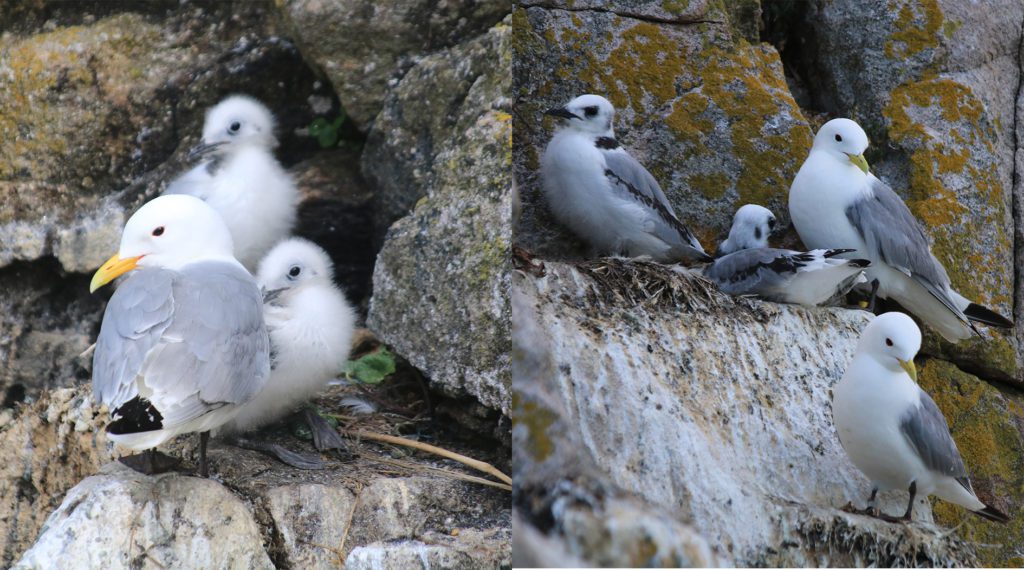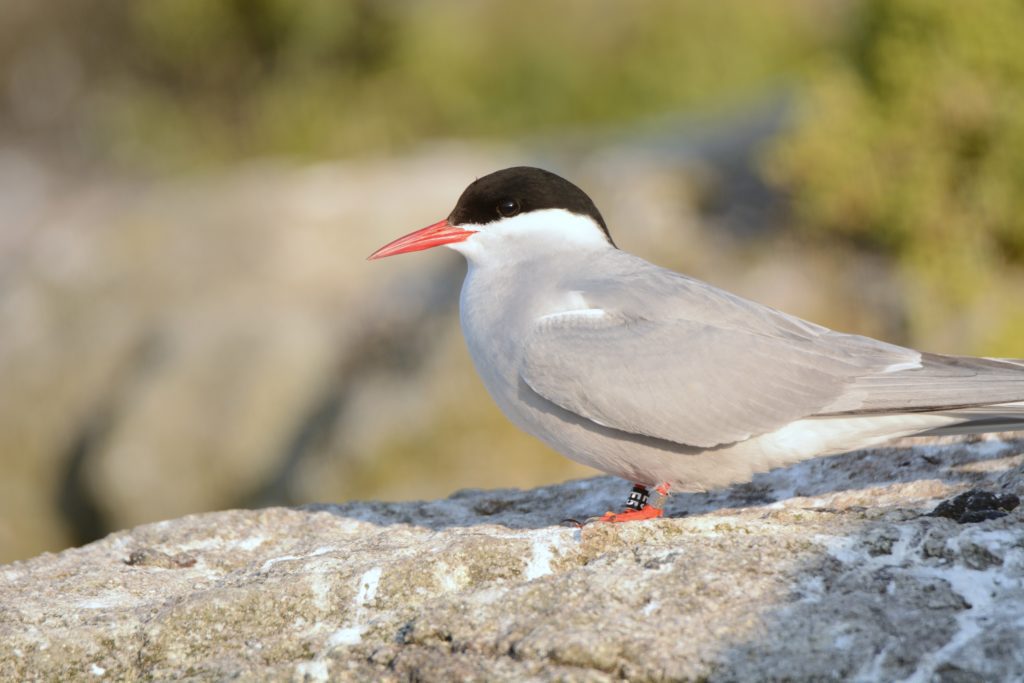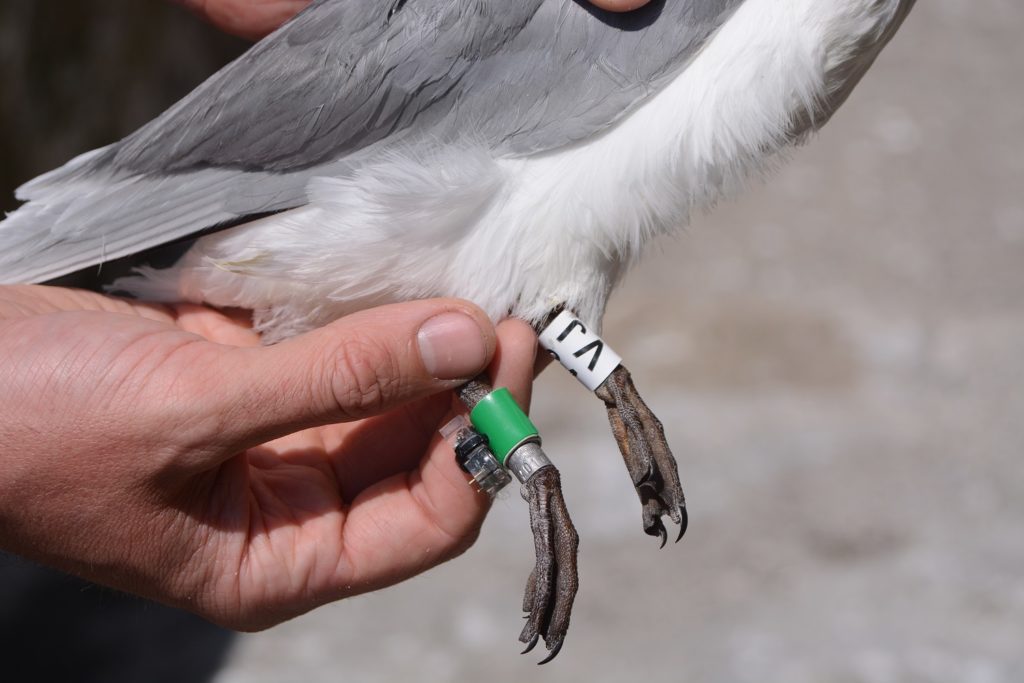Life continues to move fast out here on Rockabill. This year we recorded a record number of Roseate Tern nests on the island. That is a lot of chicks to watch over! Not only that, but each of these chicks need to be ringed with a uniquely coded leg ring so that we can continue to monitor them after they migrate and when they hopefully return to Rockabill to nest in the years to come. In no time at all our tiny tern chicks had shed their fluffy down feathers and had grown into their more elegant flight feathers.
 Common Tern chicks at different stages of their growth. Photos by Emma Tiernan, taken under NPWS license.
Common Tern chicks at different stages of their growth. Photos by Emma Tiernan, taken under NPWS license.
 Roseate tern chicks at different stages of their growth. Photos by Emma Tiernan & Alex Fink, taken under NPWS license.
Roseate tern chicks at different stages of their growth. Photos by Emma Tiernan & Alex Fink, taken under NPWS license.
Common tern chicks will start to wander away from their nest as early as 1 or 2 days old. Roseate tern chicks on the other hand will wait a bit longer and at 10 to 15 days old they will start to investigate the world outside their nest boxes.
 Common tern chick cosy under their parent on a cold day. Photo by Emma Tiernan, taken under NPWS license.
Common tern chick cosy under their parent on a cold day. Photo by Emma Tiernan, taken under NPWS license.
 Roseate tern chicks from the same clutch stepping outside their nest box for the first time. Photo by Emma Tiernan, taken under NPWS license.
Roseate tern chicks from the same clutch stepping outside their nest box for the first time. Photo by Emma Tiernan, taken under NPWS license.
It’s not just the terns, the Black Guillemots and Kittiwakes have also been getting very big, very fast.
 Black Guillemots at 5 days old (left) and over 15 days old (right) before getting weighed for biometrics analysis. Photos by Emma Tiernan, taken under NPWS license.
Black Guillemots at 5 days old (left) and over 15 days old (right) before getting weighed for biometrics analysis. Photos by Emma Tiernan, taken under NPWS license.
 Kittiwake chicks at 5 days old (left) and over 20 days old (right), now almost ready to fledge. Photos by Emma Tiernan & Alex Fink, taken under NPWS license.
Kittiwake chicks at 5 days old (left) and over 20 days old (right), now almost ready to fledge. Photos by Emma Tiernan & Alex Fink, taken under NPWS license.
Ringing Takes Time
As the tern chicks continued to grow throughout June it wasn’t long before it was time for the annual ringing blitz. While we had each ringed the majority of Roseate and common Tern chicks within our study areas, thousands of chicks still remained to be ringed around the rest of the island. We definitely would not be able to accomplish this with just the three of us. Thankfully, on the 28th of June, we were joined by Dr Stephen Newton, BirdWatch staff Brian Burke and Tara Adcock, and ringers Caroline McKeon and Thorfinn Newton to help us with this daunting task. Bird ringing is strictly licensed in Ireland through both the NPWS and BTO and requires extensive training before licenses are granted!
We spent the next 3 days sweeping through each sub-colony of the island, systematically searching every box and nest location to catch and ring every Roseate and Common Tern chick that could be found. Once caught, the chicks were given a uniquely-coded metal ring and Dr. Newton recorded the ring number and other important details including the species, location and wing size (which gives us an idea of how many days old that chick is). Once ringed, the chick was released in its original setting and we moved on with our search. It was a tedious job, but with the help of the volunteers and some good weather, we managed to get the bulk of this ringing completed quickly.
 Warden Micheal Fitzgearld and ringer Caroline McKeon busy ringing Common and Roseate chicks. Photo by Emma Tiernan, taken under NPWS license.
Warden Micheal Fitzgearld and ringer Caroline McKeon busy ringing Common and Roseate chicks. Photo by Emma Tiernan, taken under NPWS license.
Tara Adcock ringing a young Common Tern chick. Photo by Emma Tiernan, taken under NPWS license.
Good News for our Arctic Terns
We are lucky to have thirty-seven Arctic Tern pairs nesting on the Rock this year. In previous breeding seasons, Arctic tern chicks out here have not been very lucky and most nest have been destroyed by either predation or wet weather. However, this year is looking good for our Arctic terns and 17 chicks have fledged. Fifteen Arctic chicks were fitted with BTO and special colour rings. Keep an eye out for some Arctic Terns along the East coast wearing a black ring with 2 white letters on the left leg.
 Dr Steven Newton colour ringing an Arctic Tern chick. Photo by Emma Tiernan, taken under NPWS license.
Dr Steven Newton colour ringing an Arctic Tern chick. Photo by Emma Tiernan, taken under NPWS license.
 An adult Arctic Tern with a colour ring (black ‘E5’) on the right leg. Hopefully this years fledglings will return to Rockabill in the coming years! Photo by Brian Burke, taken under NPWS license.
An adult Arctic Tern with a colour ring (black ‘E5’) on the right leg. Hopefully this years fledglings will return to Rockabill in the coming years! Photo by Brian Burke, taken under NPWS license.
Climbing for Kittiwakes
There were more than just Tern chicks to ring however, and with the majority of this work completed we set about catching adult Kittiwakes from the cliff tops on the Rock. Kittiwakes are now globally red-listed, so we’re trying to increase our monitoring of this beautiful gull on Rockabill. As well as ringing them, we also attached GLS tags to each one so that their movements over the next fifteen months could be tracked. All in all, we caught twenty of these beautiful birds over the course of two days.
 Kittiwake with a GLS tag (on the green ring), plus identifying metal and colour rings, before being released back into the colony. Photo by Brian Burke.
Kittiwake with a GLS tag (on the green ring), plus identifying metal and colour rings, before being released back into the colony. Photo by Brian Burke.
The week concluded with the Steve and the volunteers’ departure, leaving the wardens to look after more and more fledglings by the day. However, we were not left for too long, as a few weeks later it was time to go climbing to ring some Kittiwake chicks. Dr. Stephen Newton returned with work experience student Hannah O’ Connor, who helped us earlier in the season with the nest census, and we set off. As Kittiwakes are cliff nesting seabirds, catching some of the chicks for ringing required some Micheal’s rock climbing expertise.
 Warden Micheal Fitzgerald has been a keen rock climber for years and was looking forward to climbing cliffs for Kittiwakes, Photo by Emma Tiernan.
Warden Micheal Fitzgerald has been a keen rock climber for years and was looking forward to climbing cliffs for Kittiwakes, Photo by Emma Tiernan.
We set to work and over the course of two days, we ringed 174 Kittiwake chicks on the Bill and on the Rock.
 The Rockabill team ringing Kittiwake chicks while Micheal waits to carefully put them back in their nests. Photo by Emma Tiernan, taken under NPWS license.
The Rockabill team ringing Kittiwake chicks while Micheal waits to carefully put them back in their nests. Photo by Emma Tiernan, taken under NPWS license.
While its always enjoyable to find fluffy Kittiwake chicks, the work was made a bit more difficult as we worked through the recent heatwave. At the end of each day the wardens and Hannah enjoyed a well-deserved swim in the sea. After a very sweaty few days, it was time for Dr Newton to leave us again and we were once again left to our own devices, this time, however, on an island bustling with teams of busy fledglings, as they took to the air for the first time.
– Micheal, Emma and Alex, Rockabill Team
(PS – Don’t forget to keep an eye out for terns roosting around the coast at this time of year, and let us know via the link here)
This year’s work to protect and monitor the terns and other breeding seabirds on Rockabill would not be possible without support from the National Parks and Wildlife Service and the cooperation of the Commissioners of Irish Lights.
To revisit news and blogs from previous years on Rockabill, click the link here.


 Common Tern chicks at different stages of their growth. Photos by Emma Tiernan, taken under NPWS license.
Common Tern chicks at different stages of their growth. Photos by Emma Tiernan, taken under NPWS license. Roseate tern chicks at different stages of their growth. Photos by Emma Tiernan & Alex Fink, taken under NPWS license.
Roseate tern chicks at different stages of their growth. Photos by Emma Tiernan & Alex Fink, taken under NPWS license. Common tern chick cosy under their parent on a cold day. Photo by Emma Tiernan, taken under NPWS license.
Common tern chick cosy under their parent on a cold day. Photo by Emma Tiernan, taken under NPWS license. Roseate tern chicks from the same clutch stepping outside their nest box for the first time. Photo by Emma Tiernan, taken under NPWS license.
Roseate tern chicks from the same clutch stepping outside their nest box for the first time. Photo by Emma Tiernan, taken under NPWS license. Black Guillemots at 5 days old (left) and over 15 days old (right) before getting weighed for biometrics analysis. Photos by Emma Tiernan, taken under NPWS license.
Black Guillemots at 5 days old (left) and over 15 days old (right) before getting weighed for biometrics analysis. Photos by Emma Tiernan, taken under NPWS license. Kittiwake chicks at 5 days old (left) and over 20 days old (right), now almost ready to fledge. Photos by Emma Tiernan & Alex Fink, taken under NPWS license.
Kittiwake chicks at 5 days old (left) and over 20 days old (right), now almost ready to fledge. Photos by Emma Tiernan & Alex Fink, taken under NPWS license. Warden Micheal Fitzgearld and ringer Caroline McKeon busy ringing Common and Roseate chicks. Photo by Emma Tiernan, taken under NPWS license.
Warden Micheal Fitzgearld and ringer Caroline McKeon busy ringing Common and Roseate chicks. Photo by Emma Tiernan, taken under NPWS license.
 Dr Steven Newton colour ringing an Arctic Tern chick. Photo by Emma Tiernan, taken under NPWS license.
Dr Steven Newton colour ringing an Arctic Tern chick. Photo by Emma Tiernan, taken under NPWS license. An adult Arctic Tern with a colour ring (black ‘E5’) on the right leg. Hopefully this years fledglings will return to Rockabill in the coming years! Photo by Brian Burke, taken under NPWS license.
An adult Arctic Tern with a colour ring (black ‘E5’) on the right leg. Hopefully this years fledglings will return to Rockabill in the coming years! Photo by Brian Burke, taken under NPWS license.
 Kittiwake with a GLS tag (on the green ring), plus identifying metal and colour rings, before being released back into the colony. Photo by Brian Burke.
Kittiwake with a GLS tag (on the green ring), plus identifying metal and colour rings, before being released back into the colony. Photo by Brian Burke. Warden Micheal Fitzgerald has been a keen rock climber for years and was looking forward to climbing cliffs for Kittiwakes, Photo by Emma Tiernan.
Warden Micheal Fitzgerald has been a keen rock climber for years and was looking forward to climbing cliffs for Kittiwakes, Photo by Emma Tiernan. The Rockabill team ringing Kittiwake chicks while Micheal waits to carefully put them back in their nests. Photo by Emma Tiernan, taken under NPWS license.
The Rockabill team ringing Kittiwake chicks while Micheal waits to carefully put them back in their nests. Photo by Emma Tiernan, taken under NPWS license.